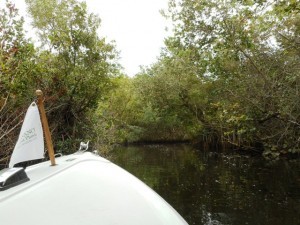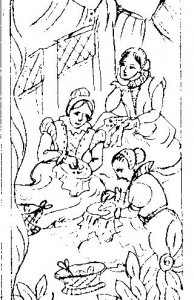Kathy Lynn Emerson's Blog, page 78
April 6, 2016
SWAMP & STREAM
Susan Vaughan here. I know, my title’s a bad takeoff on Field & Stream. My post today is a nature travelogue of my recent week in southwest Florida. With my husband and other family members, I visited two nature conservancy centers that were reminders both of human’s adverse effects on the environment and of the human efforts to save it. Attacks on the environment, whether purposeful or inadvertent, happen everywhere, but these tours also nudged me to compare Maine and Florida.
In Maine, we’re concerned about our old growth forests. In Florida, cypress trees are endangered. The Corkscrew Swamp Sanctuary in Naples was established to protect the largest remaining stand of bald cypress left in North America.
When acquired in 1954, in cooperation with the Audubon Society, the swamp was isolated and almost impossible to access. Today the sanctuary preserves native plants, native animals, and the cypress. We walked the boardwalk that winds its way through and around the swamp. Bald cypress once dominated the deep swamps of Florida and the Southeastern U.S. They lose their needles during the winter, hence the name “bald.” Scientists used to think that cypress “knees,” the knobby growth in the water, both stabilizes and feeds the parent tree, but they have since learned the knees are only for stabilization.
Some of the cypress are hundreds of years old. I have to rely on memory, but I believe the oldest is the Muir Tree, over 500 years old and too large for a photo to do justice. There are twelve species of air plants in the swamp. Related to the pineapple, they’re not parasites, but take their nutrients from the rainfall and falling organic debris.
Water fern floats and can cover large expanses of the water’s surface. Blue flag irises are found in Maine, and we found many in the sunnier parts of the swamp. Some creatures there also live in Maine, a pileated woodpecker and a raccoon. Not so the snowy egret happily munching greens as we passed by. We were told that people occasionally spot alligators and Florida panthers.
Florida panthers are tawny like cougars, but smaller. No panther for us, but the next day, a woman from Wisconsin videoed a panther running along the boardwalk. I’d have been so shocked, I couldn’t have held the camera, but she didn’t even shake the camera. You can see the news coverage here. Instead, here’s the alligator we saw.
Our other nature tour was to the Conservancy of Southwest Florida Nature Center, also in Naples. Their motto could apply to Maine as well: “Our Water, Land, Wildlife, Future.” Their work and fundraising protects and educates about all of those areas. We toured the nature center and then boarded their electric tour boat for a ride through the lagoon and on the small Gordon River.
In this location, the endangered trees were mangroves. Our guide wasn’t as specific as the NOAA website, which tells me that mangrove trees grow in tropical and sub-tropical areas with low-oxygen soil, where slow-moving waters allow fine sediments to accumulate.
Their dense “prop” roots make the trees appear to be standing on stilts above the water. This tangle allows the trees to handle the daily rise and fall of tides. They stabilize shorelines, whether on the coast or here on this river, maintain water quality and clarity, and filter pollutants and sediments.
Mangroves are homes to shrimp, crustaceans, mollusks, and fish. They also support nesting birds and larger animals like alligators and turtles. Along the river, our guide pointed out a pair of nesting yellow-crowned night herons, but the boat passed too quickly for me to snap their picture. You’ll have to look it up in your birding book.
And big doings coming next week. April 10-16, National Library Week, the Maine Crime Writers are planning some special fun. And at the end of the month, one lucky commenter will win a gift basket with Maine treats and Maine reads.
April 5, 2016
English Translation of English
Dorothy Cannell: I was talking with a friend (aka husband) recently and we agreed that the words he or she ‘meant well’ have to be amongst the most damning in the English language. Conclusion: Outcome may range between disappointing and disastrous, but is never good.
Example: John is a romantic; he meant well. Possible response:
‘Yes, I don’t doubt John thought he was being a pal inviting Mary Smith and her ex-husband to the dinner party in hope of bringing about a reconciliation, but we’re still looking at a body with a steak knife sticking out of its back.”
And while on the subject of red flag-waving assertions, my friend and I considered the phrase: “To be completely frank with you …”
Why the need to assert honesty with adverb to boot? Could suggest to the suspicious that this hasn’t always been the case or even (to a nasty-minded person) that the speaker is fibbing now.
This vein of thought reminded me that one of the things likely to make dialogue come alive for me on the page is the suggestion that a character’s words can’t be taken at face value, thereby allowing for probing of his or her personality and that of others participating in the conversation. Denials are often promising.
Example: A Woman invited to have another piece of cake. 
“I really mustn’t be greedy!”
Possible interpretation: She’s dying for a really big slice.
Possible kindly response from other character: “Are you sure? It would be a pity to let it go stale.”
Or, nastily: “Very sensible. We can all do with losing a little weight if we are to make any attempt at looking our best.”
The more vehement the denial the more grist for the poking.
Example: Person asked about his (her) reaction to coming into a large inheritance.
“It’d never crossed my mind, not once in twenty years of doing Uncle Henry’s shopping and cooking his dinner three or four times a week, that he’d leave me his house and all that money. You could’ve knocked me down with a feather when the solicitor read out the will.”
Possible interpretation: Had been counting down the minutes until the old boy kicked the bucket.
Possible kindly response: “I’m sure it didn’t. No one could ever think you grasping.”
Or nastily: “Pull the other leg. It’s got bells on.”
 Here’s another potential denial gem: Woman asked she thinks of the vicar’s recently announced engagement to the visiting nurse.
Here’s another potential denial gem: Woman asked she thinks of the vicar’s recently announced engagement to the visiting nurse.
“I have absolutely nothing to say on the matter!”
Possible interpretation: Bursting at the seams to have her say into the middle of the next week.
Kindly response: “I shouldn’t have brought up the matter, not with you being his housekeeper.”
Or nastily: “Really? Who could blame you for feeling murderous after years of slavishly going above and aboard the job description? Oh, yes! Poor fool, you! What a shame you’re not a rich blonde with a bishop for an uncle!”
It’s wonderful when one small remark kicks the dialogue forward and in doing so propels the plot – possibly in a previously unforeseen direction. Which reminds me, I should get back to book in progress. But in ending I would like to add one final thought: To be absolutely frank I have never had the smallest desire to be Number One on the New York Times best seller list, win a Pulitzer or get a three million dollar advance.
Best wishes,
Dorothy
April 4, 2016
Between Revisions
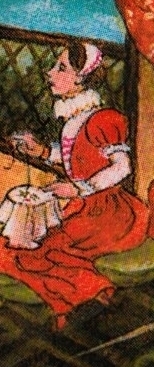 There are a few writers out there who can dash off a manuscript and get it right the first time. They self-edit in their heads before they put fingers to keyboard. For most of us, however, producing a short story or a novel requires writing several drafts, and that’s before an editor lays eyes on it. The earliest one is usually called the first draft, but it also goes by other names, among them rough draft, shit draft, and no-one-sees-this-but-me draft. The process that leads to a final draft is called revising or rewriting. Between drafts, I like to let my manuscript “rest” for as long as possible, so that I can come back to it with fresh eyes and fresh ideas. That’s where I am now. I’ve done the first “read thru/revision” of the “rough draft” and it (and I) are taking a break.
There are a few writers out there who can dash off a manuscript and get it right the first time. They self-edit in their heads before they put fingers to keyboard. For most of us, however, producing a short story or a novel requires writing several drafts, and that’s before an editor lays eyes on it. The earliest one is usually called the first draft, but it also goes by other names, among them rough draft, shit draft, and no-one-sees-this-but-me draft. The process that leads to a final draft is called revising or rewriting. Between drafts, I like to let my manuscript “rest” for as long as possible, so that I can come back to it with fresh eyes and fresh ideas. That’s where I am now. I’ve done the first “read thru/revision” of the “rough draft” and it (and I) are taking a break.
Sort of.
The project (the third Mistress Jaffrey Mystery) may be on a back burner, but it’s still cooking. To be more specific, all sorts of “little things” cropped up during the first revision. Before I start the next one, I needed to do more research on some specific issues and check my facts on others,
 To help me with this process, I have two people reading all or part of what I’ve already written. My husband, who is also my trusted beta reader, gets the entire book, which he will read on his iPad. He’ll give me “notes” after he’s done, particularly on continuity and whether or not what I’ve written makes sense. I also sent about thirty pages, all the material having to do with ships and seafaring, to James L. Nelson, nautical expert extraordinaire. He knows sixteenth-century ships, having sailed as a member of the crew on the replica of the Golden Hinde, and he also knows a lot about pirates. My knowledge of these things comes entirely from books, so he has helped me catch some bloopers. Luckily, fixing them didn’t require too much rewriting. The ship pictured here, by the way, is not the Golden Hinde, but rather the replica of the Mathew, which is closer in size to the ship in my novel.
To help me with this process, I have two people reading all or part of what I’ve already written. My husband, who is also my trusted beta reader, gets the entire book, which he will read on his iPad. He’ll give me “notes” after he’s done, particularly on continuity and whether or not what I’ve written makes sense. I also sent about thirty pages, all the material having to do with ships and seafaring, to James L. Nelson, nautical expert extraordinaire. He knows sixteenth-century ships, having sailed as a member of the crew on the replica of the Golden Hinde, and he also knows a lot about pirates. My knowledge of these things comes entirely from books, so he has helped me catch some bloopers. Luckily, fixing them didn’t require too much rewriting. The ship pictured here, by the way, is not the Golden Hinde, but rather the replica of the Mathew, which is closer in size to the ship in my novel.
On my own, I needed to check three things by doing a keyword search and charting when they turn up. One was the word invasion, since the nebulous threat of an invasion plays a key role in spy subplot that goes along with the murder mystery. The other two were the names of suspects. For each of them I needed to make a timeline to make sure I didn’t accidentally say they were somewhere they can’t be. Both need to remain on Rosamond’s list of suspects for as long as possible. That was pretty easy to do, and turned up no surprises, only a couple of places where I needed to clarify how long one of those suspects was out of sight.
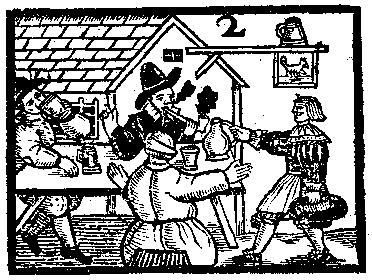 I also had to do some new research. This book is set in Cornwall. I knew that going in, and I did some research on the Cornish language before I started writing. The thing is, there’s also a Cornish dialect of English. In the draft, most of my characters sounded pretty much the same, but some are from London and the home counties, some are natives of Cornwall, and a couple hail originally from Westmorland. They wouldn’t all talk the same way today, let alone in the sixteenth century.
I also had to do some new research. This book is set in Cornwall. I knew that going in, and I did some research on the Cornish language before I started writing. The thing is, there’s also a Cornish dialect of English. In the draft, most of my characters sounded pretty much the same, but some are from London and the home counties, some are natives of Cornwall, and a couple hail originally from Westmorland. They wouldn’t all talk the same way today, let alone in the sixteenth century.
Language is always a dilemma in historical novels, and not only because writers try to avoid glaring anachronisms and obvious Americanisms. If I wrote dialogue the way Elizabethans actually spoke, their conversations would come across as bad imitation Shakespeare. A little of that goes a long way. So, you ask, if my major characters aren’t speaking exactly as they would in 1584, why do my Cornish characters need to sound authentic? A little goes a long way there, too, but I have to be sure I use the right little bits. That meant dipping into linguistics books, particularly Peter Trudgill’s The Dialects of England. Where Londoners used “you.” Cornish English speakers still said “thee.” They also said things like “I wished a good day to she,” and “Us be goin’,” “It do seem to I,” and “I be” instead of “I am.” Add a few words unique to Cornwall, like “smitch” for the dirty smoke from a fire, and I can capture the flavor of the language. The trick was to reconfigure the dialogue I need into those speech patterns. Not easy! At the moment, I’m compromising in places by having Rosamond “translate” what she hears.
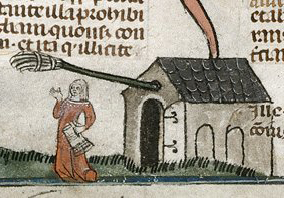
the alewife in front of her alehouse
There were also some relatively minor changes and additions I needed to make as a result of having increased my general knowledge of the way things were done in Elizabethan times. From reading Ruth Goodman’s wonderful How to be a Tudor, I gained a better understanding of how an eight-year-old boy in a gentry household would be expected to behave and have fleshed out his character. I also have a new perspective on the taste and texture of some of the food my characters eat. I’ll probably add a few more descriptive details at mealtimes on the next pass, but I have to be careful not to add too much. Nobody likes an information dump. The biggest change will be to the scenes that take place in an alehouse. Even before I read Goodman’s comments on alehouses, I had realized that mine was simply too large an establishment for the time and place. I’ve now gone through all those scenes to make them more accurate.
 I’m still in a quandary about one thing. Rosamond Jaffrey is something of a rebel, so I can get away with defying convention, but when I do I have to be sure I can make her actions believable for 1584. She’s already disguised herself as a boy in earlier books. I know of instances when real women did so, despite the fact that it was illegal. What I didn’t realize until I read Goodman’s book was that cross-dressing was specifically forbidden by St. Paul. In this book, I really want to leave the windows open and the bed curtains pulled back overnight, but most Tudor people believed that the night air carried infection and shut everything up tight when it got dark. At the moment, the window is still open. I don’t know how else Rosamond can hear something outside the house in the middle of the night.
I’m still in a quandary about one thing. Rosamond Jaffrey is something of a rebel, so I can get away with defying convention, but when I do I have to be sure I can make her actions believable for 1584. She’s already disguised herself as a boy in earlier books. I know of instances when real women did so, despite the fact that it was illegal. What I didn’t realize until I read Goodman’s book was that cross-dressing was specifically forbidden by St. Paul. In this book, I really want to leave the windows open and the bed curtains pulled back overnight, but most Tudor people believed that the night air carried infection and shut everything up tight when it got dark. At the moment, the window is still open. I don’t know how else Rosamond can hear something outside the house in the middle of the night.
All these questions will be answered, as they used to say at the end of soap operas, in the next installment. Make that revision. In the meantime, minor corrections having been made, the manuscript really is resting. When I start the second read thru/revision, I’ll be looking for places to add descriptive details but I’ll also be looking for unnecessary words, descriptions, and even whole scenes that should be cut. I’ll do that revision and at least one more. The final pass will be a read thru aimed at fixing typos, adding missing words, and eliminating any remaining unnecessary or repetitious words. What I submit will be as “clean” as I can make it, if only because it’s just plain embarrassing to have an editor catch stupid mistakes.
It’s even worse when they slip past everyone involved in the editorial process and readers spot them.
Kathy Lynn Emerson/Kaitlyn Dunnett is the author of over fifty books written under several names. She won the Agatha Award in 2008 for best mystery nonfiction for How to Write Killer Historical Mysteries and was an Agatha Award finalist in 2014 in the best mystery short story category for “The Blessing Witch.” Currently she writes the contemporary Liss MacCrimmon Mysteries (The Scottie Barked at Midnight) as Kaitlyn and the historical Mistress Jaffrey Mysteries (Murder in the Merchant’s Hall) as Kathy. The latter series is a spin-off from her earlier “Face Down” series and is set in Elizabethan England. Her websites are www.KaitlynDunnett.com and www.KathyLynnEmerson.com
April 3, 2016
When a (Writing) Retreat is a Step Forward
 Lea Wait here. Many of you know this has been a challenging winter for my husband and for me. As I’m writing this he is in the hospital having two stents put in his left leg. He’s been there a week, and has another couple of days to go before he can come home. This is his third hospitalization since mid-January. And I had kidney surgery last week — and will have it again this Friday.
Lea Wait here. Many of you know this has been a challenging winter for my husband and for me. As I’m writing this he is in the hospital having two stents put in his left leg. He’s been there a week, and has another couple of days to go before he can come home. This is his third hospitalization since mid-January. And I had kidney surgery last week — and will have it again this Friday.
Of course, our top priority has been taking care of each other and our health issues. But the reality of art galleries expecting new paintings from Bob, and my next mystery due to Kensington on May first, in a year when mystery authors are being dropped left and right, has meant we can’t divest our artistic obligations.
It hasn’t been easy. I was especially worried since I sent my previous book in at the end of January, and knew I only had a little over 3 months to complete the next one.
Somehow I wrote about fifty pages. A pittance.

Pics are views from the porch of the home where I was staying.
Bob was doing better, but, even with only two of us at home, after his stroke I’d picked up the cooking and chores he usually did, and was the one organizing doctors’ visits and paying bills. I wasn’t writing. I was beginning to panic.
Once a couple of years ago I had the opportunity to leave home and spend five days alone, doing nothing but writing. It was an incredibly productive week. I have a writing friend who takes herself on solo “retreats” several times a year — checks herself into a hotel in a remote spot and writes. So when Bob and one of our neighbors suggested I take a week away from home I hesitated, but then couldn’t resist.
I left Bob with casseroles and sandwich makings and frozen pizzas and spent 6 1/2 days at the neighbor’s house, semi-closed for the winter, on the edge of the sea. The neighbor made sure the heat was on, a telephone was available, and I had internet access. I brought simple food with me for the week.
And I wrote over 150 pages. A first draft, sure. But not a bad one. I kept in touch with my husband by telephone, and the neighbor stopped in several times. Bob was fine. In fact, he produced two paintings that week.
And my deadline looked within reach.
For anyone else considering such a step, here are a couple of suggestions, based on my experience:
Prepare outlines, character sketches, plot lines — whatever you need — before you go. You’re there to write, not research. Leave blank spaces in your manuscript if you must.
Take food that is easy to prepare and light. You don’t want to fall into a carb stupor. Ditto alcohol. I did take a bottle of sherry and treated myself to a glass at the end of my writing day. (I also took jelly beans!)
Don’t worry about clothes. You won’t be seeing anyone. Comfort is the key — sweats, slippers — whatever is relaxing for the season. (You also won’t need makeup. But I did take bath salts. Working at a keyboard 10+ hours a day is rough on back and shoulder muscles.)
Give yourself a break from your manuscript at night. Watch light tv, or read something in a different genre from the one you write in. You may still find thoughts of plots flickering through your brain, though — make sure you have paper and pencil wherever you are.
If you can, depending on season and weather, take a walk each day. Or at least breathe some fresh air.
Don’t worry about word or page counts when you’re working … just keep going. But keep track, so you can pat yourself on the back as the words add up.
Bottom line: would I do this again? Without a doubt. I felt peaceful, productive, and, best of all, not distracted by issues at home. It worked.
For those of you who can sit at home and write 20-25 pages a day on a regular basis — Bravo! (or Brava!) But I normally produce 5 to 10 pages on a good day. Allowing myself the freedom just to write was a great gift.
And, although life has tumbled around me again, I’m still hoping to get my book in on time.
For me, that almost-one-week retreat was a major step forward. I can hardly wait to do it again. I recommend it to anyone who’s in a tough writing space.
P.S. If any of you are interested in duplicating my retreat, the home I stayed at belongs to Barbara and JD Neeson. It’s in Spruce Head, Maine, and is isolated — no other homes around – rustic, built in 1905, with 5 bedrooms + 2 baths — and books and art everywhere! To find out more, check with them at bneeson@live.com (They said I could post that!)
Lea Wait writes the Mainely Needlepoint series (the most recent of which is Thread and Gone) and the Shadows Antique Print Mystery series (the most recent of which is Shadows on a Maine Christmas.) New books in each series will be published later this year. Lea also writes historical novels set in 19th century Maine. http://www.leawait.com
April 1, 2016
Weekend Update: April 2-3, 2016
 Next week at Maine Crime Writers there will be posts by Lea Wait (Monday), Kathy Lynn Emerson/Kaitlyn Dunnett (Tuesday), Dorothy Cannell (Wednesday), Susan Vaughan (Thursday), and Bruce Coffin (Friday).
Next week at Maine Crime Writers there will be posts by Lea Wait (Monday), Kathy Lynn Emerson/Kaitlyn Dunnett (Tuesday), Dorothy Cannell (Wednesday), Susan Vaughan (Thursday), and Bruce Coffin (Friday).
An invitation to readers of this blog: Do you have news relating to Maine, Crime, or Writing? We’d love to hear from you. Just comment below to share.
And a reminder: If your library, school, or organization is looking for a speaker, we are often available to talk about the writing process, research, where we get our ideas, and other mysteries of the business. Contact Kate Flora: mailto: kateflora@gmail.com
March 31, 2016
April Fools Day is about as fun as dog poop fudge
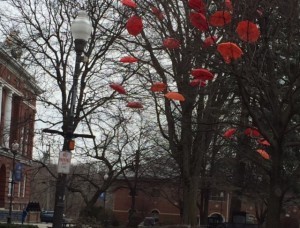
These umbrellas in the tree in Waterville are my kind of April Fools “trick.” Whimsical and realistic and no one gets hurt.
By Maureen Milliken
I’m not a fan of April Fools Day. I don’t know if that puts me in the minority or not.
I’ve never liked pranks or jokes that make people look stupid. I also — and this is weird for a mystery fiction writer to say, I know — don’t like things presented as real that aren’t. So those April Fool’s Day spoofs — fake news reports, people who pretend they’re Oprah calling to say she’s picked your book for her show, Candid Camera-type substituting dog poop for the plate of fudge — irritate me.
I’m not sure if that’s because I’m a journalist, or I became a journalist because I prefer grim reality.
I don’t like to read or watch much related to sci-fi, fantasy, time travel, unicorns, supernatural powers, parallel universes (except that one episode of Lost in Space, because evil Don West was kind of sexy), zombies, vampires, wizards, superpowers…well, you get it.
I’d rather watch a well-done documentary about a real-life crime than a movie about a real-life crime. Really good movies about real crimes — Zodiac, In Cold Blood — I love. But I like documentaries more than a movie about something that really happened. Documentaries with re-enactments? Not so much.
That said, I love mystery fiction. I know it’s not reality. I know there are elements of mystery fiction, like the amount of murders in a small town or the newspaper editor helping to solve those murders and being in life-threatening situations, are not reflections of reality.
I love writing mysteries, particularly dealing with my characters and what happens to them. But this whole week as I “finished” my mystery novel No News is Bad News, that little voice in my head kept saying “Are people really going to buy into this is happening after what happened in the last book?”
No News is Bad News is the second in the Bernie O’Dea mystery series. Bernie (short for Bernadette) is the 40-something editor of a weekly newspaper in Franklin County, Maine. She has no mad self-defense skills, doesn’t like guns and can’t shoot one well when she is forced to, isn’t a genius in any way shape or form. So she’s more or less “normal.”
Somehow, though, she and the police chief get in these situations…
So that voice that hates non-reality, pranks, unicorns, dog poop fudge and all that other stuff said to me as I joyfully killed people and did all sorts of mean and nasty stuff to my characters, “Really?”
I attributed that voice to plot-tweak overload (a blog subject for another day) and kept writing.
On top of all that is the realization, never more clear than when you’re trying to make a plot work, that everything has to be tied up and explained. What can be less like real life than that?
As a journalist, that’s another thing that’s clear every day. No one will ever really know just what happened to Kim Hill, for instance, the woman who fell/jumped/whatever out of the cab of her boyfriend’s pickup truck on U.S. Route 201 at 2 a.m. on a Sunday a couple weeks ago. Missing Waterville toddler Ayla Reynolds? What would have been her 6th birthday is April 4 and police are no closer to finding out what happened to her than they were when se was reporting missing December 17, 2011.
So, in a mystery series, you can kill off more people in a town than the entire state of Maine does in a year, you can rain all kinds of havoc down on the heads of your “normal” protagonists, mysterious strangers can do all sorts of nefarious things, but you damn well better explain it.
In No News is Bad News I try to play a little with perception versus reality, with what happens when perception and reality clash and how questions get answered in light of that. Don’t worry, I know that makes it seem like something they made you read in college Comparative Literature, but it’s not nearly as heavy as it sounds.
Still, it was a fine line to walk. If there are questions that remain, the possible answers still have to satisfy readers.
I understand that, because even though I am not entertained by all the stuff listed above (no I won’t indulge my need to write dog poop fudge one more time), I rarely question the body count, broken bones, mysterious strangers, or anything else in mystery series. I just enjoy the ride.
Writers will tell you — at least ones who writer the way I do — that writing is a wild ride and you never know where it’s going to take you.
If readers have half as much fun reading my first two books as I did writing, I’ll consider it a triumph and try not to worry too much about the horrific twists and turns of book number three. And that’s no joke.
Maureen Milliken is the author of Cold Hard News, released in 2015, and No News is Bad News, due to be released this summer, the first two books in the Bernie O’Dea mystery series. Follow her on Twitter: @mmilliken47 or on Facebook at Maureen Milliken mysteries. Sign up for email updates at maureenmilliken.com. Maureen will be at the Lithgow Library in Augusta, Maine, 1-3 p.m., April 14 as part of a Sisters in Crime New England Speakers Bureau panel speaking on “The Modern Heroin.” On April 27, from 6-8 p.m., she will speak at the Belgrade Public Libary, Belgrade, Maine, on “Journalism and Writing.”
March 30, 2016
We’re Not Just About Moose and Lobsters, Ya Know
 From time to time, the Maine Crime Writers do a group post. This one builds on that children’s game where you’re going on a trip and bringing along X, Y, and Z. So, everyone was asked to answer this question:
From time to time, the Maine Crime Writers do a group post. This one builds on that children’s game where you’re going on a trip and bringing along X, Y, and Z. So, everyone was asked to answer this question:
I am packing a basket full of goodies from Maine, and I am putting “X” in it.
Kate Flora: I am putting in Raye’s mustard, Ducktrap smoked trout, and Stonewall 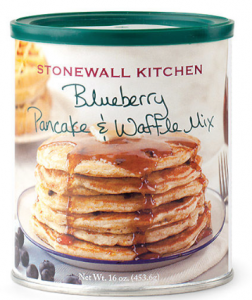 Kitchen pancake mix. http://www.stonewallkitchen.com
Kitchen pancake mix. http://www.stonewallkitchen.com
Bruce Coffin: A six-pack of Moxie and some venison jerky!
Chris Holm: Gunpowder Rye from New England Distilling and some infusion kits from Vena’s Fizz House.
http://www.newenglanddistilling.com/spirits/rye-whiskey/ http://shop.venasfizzhouse.com/collections/infusion-kits
Maureen Milliken: Claudia Diller Maine scenes calendar and Carrabassett Coffee http://www.carrabassettcoffee.com
 Kathy Lynn Emerson: A jar of Pemberton’s Death by Chocolate, a whoopie pie from Wicked Whoopies www.wickedwhoopies.com and a half pint of Maine maple syrup from any local producer
Kathy Lynn Emerson: A jar of Pemberton’s Death by Chocolate, a whoopie pie from Wicked Whoopies www.wickedwhoopies.com and a half pint of Maine maple syrup from any local producer
Susan Vaughan: Bixby Chocolate Bars and Rock City Coffee, made in Rockland http://www.bixbyco.com
Lea Wait: Blueberry Jam from Stonewall kitchen! Cranberry Gin from Sweetgrass Farm! Whoopie Pie! And a barley sugar lobster lollypop. (Or gummy lobsters – my grandkids’ favorite!)
Brenda Buchanan: A gift certificate good for a couple of growlers of fine beer from Marshall Wharf Brewing in Belfast along with the never-gets-old collection of essays by E.B. White titled One Man’s Meat. (Food for the soul.) http://www.marshallwharf.com
DRINK MAINE BEER!
John Clark: Gift cards from Casablanca Comics and Bullmoose. Two great Maine  operations. Rick at Casablanca is the guru of Manga for the Maine Library community and Bullmoose offers great service and the stores are lots of fun to browse.
operations. Rick at Casablanca is the guru of Manga for the Maine Library community and Bullmoose offers great service and the stores are lots of fun to browse.
Barbara Ross: Coastal Maine Popcorn–both savory and sweet– www.coastalmainepopcorn.com
And lest you think we live on nothing but gourmet treats and Maine roasted coffee, Vaughn Hardacker reminds us of some more down to earth Maine eats: How about the most popular lunch in THE COUNTY! Red hotdogs, burnt black, and Humpty Dumpty BBQ potato chips
Dying to get your hands on some of these treats? Well one lucky commenter during the 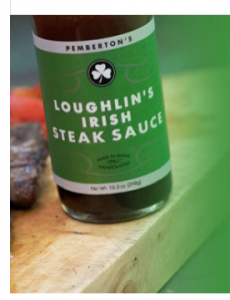 month of April will be getting a gift basket with Maine treats and Maine reads, including some Loughlin’s Irish Steak Sauce http://loughlinirish.com
month of April will be getting a gift basket with Maine treats and Maine reads, including some Loughlin’s Irish Steak Sauce http://loughlinirish.com
So keep those comments coming, folks.
And stay tuned for the fun we’re planning for National Library Week, April 10-16. Last year it was library card socks. This year? Well, we’re not telling until April 10th.
Written with Permission
Bruce Robert Coffin here, introducing a debut guest blogger to Maine Crime Writers. Peter Murray is a friend, fellow retired cop, and fellow writer (although he cringes each time I call him that). Pete is also a tremendously talented chef. As he will tell you, the art of cuisine shares much with the art of writing. Pete sent me the following blog which I will now share with you. It made me smile and made me hungry. Bon appetite!
Written with Permission
I wanted to start my writing day by making a couple of observations. Well, I have already made them, but I am about to write them down so that I can remember them in time of need. The first significant thing that happened this weekend is that my wife went away. That cuts both ways. I miss her, and the house seems empty despite my mother-in-law, two dogs, and three cats, all of whom demand that I feed them. But feeding them, particularly mother-in-law, who I call “Visa” because she seems to be everywhere I want to be, has lead to revelations.
The result of my wife’s absence, aside from no distractions of vacuum cleaning, litter box sanitation in my writing space, and interruptions for other domestic intercourse (Not what you’re thinking. I would gladly stop for that) is that I have of necessity moved my writing to the dining room table. This facilitates a watchful eye on Visa and allows me to cook with minimal interruption to my writing.
Inasmuch as I enjoy cooking, and do it professionally, I have often noted that routine of preparation allows a great deal of time being given over to the muse. In a professional setting, which is most often the case, I have neither the time or the indulgence of my employer to stop amid a Hollandaise sauce to jot notes, rewrite sentences, or play around with a herring, be it red or smoked.
When cooking, and thinking about writing, limitations are imposed upon the written word. When writing and cooking those limitations are put in juxtaposition. Momentary synapse collapse is overcome by letting things stew, stirring gently until thickened.
Observation number two: Although that I am, and on various levels at various times always have been, I choke on the phrase, “a writer.” If I do manage to spit it out, I have to overcome the temptation to leap forward mouth wide open and snatch it back like a hungry trout devouring a caddis fly. If I saw at lumber, am I a carpenter?
Save for newspaper articles, several under a pseudonym, reposing in the stack of the historical society, I have produced nothing. The word nothing does not fully describe my state of being. Nothing is nothing, nada, zilch, an empty space. My nothing comes with insecurity, self-doubt and the unshakable feeling that I should get my lazy ass out the door and earn a living. At the very least, I should make something.
Yesterday, writing as described above, I finished a short story. “Damn, I like it,” I said to no one. “No one else will,” someone answered. I put it away to let it percolate, to steep, to let its flavor maturate. It was then that banter (via Facebook of course) turned to gumbo.
The gumbo Kate Flora was cooking of a literary nature. It engender a literal rendition in my kitchen. Amid the chopping of the trinity, the slicing of the andouille and the cooking of the roux, I recalled an article, published only on my blog, that I had written some time back.
Kate to my mind is the queen of Maine Crime Writers, a Katherine the Great in the fiefdom of mystery and suspense. I dared not approach the throne with my treatise on gumbo. Instead, I sent it to Bruce, a friend, fellow law enforcement comrade, and at that moment acting as jester in our Facebook audience with royalty.
It was not my intent for him to publish. I had only sent him the article so that he might glean just how serious the discussion of gumbo can get. There are opinions, dissents, concurrences and joins. The holding and the dicta, require reams. But publish it he did.
Of course, being a man of letters, he could not simply cut and paste. In way of introduction he wrote, “My friend, fellow law dog, and writer.” Our friendship, our brotherhood as former police officers, go beyond a click, a like, and a share. His acknowledging me as a writer has granted me a permission I could not give myself.
March 28, 2016
The Grammy Game
 Every family has inside jokes, stories and strategies for handling the things life throws at you. My family is all from Maine so it’s not surprising that the stories and strategies often involve thrift and ingenuity. The wisdom has been handed down as a sort of verbal inheritance and it pays dividends, often when you wouldn’t expect it.
Every family has inside jokes, stories and strategies for handling the things life throws at you. My family is all from Maine so it’s not surprising that the stories and strategies often involve thrift and ingenuity. The wisdom has been handed down as a sort of verbal inheritance and it pays dividends, often when you wouldn’t expect it.
My maternal grandmother was one of those women, so often found in northern New England, who could make a nickel, or a loaf of bread or a box of laundry soap stretch in ways that can only be described as Biblical. Every single time I think a jar of mayonaise isn’t worth tackling with a rubber scrapper I can hear her clearing her throat in my ear. I dutifully poke round the inside of it and come up with enough for my grandmother to have made a dozen deviled eggs.
My sister and I each live in rural communities where a trip to the grocer will involve half an hour travel each way. By the time you’ve scraped the car and run back into the house for your reuseable grocery bags the event turns into a morning-long affair. On a rainy day or a snowy one, the idea of heading out to the shops is more than either of us is up to facing. So years ago we came up with something we call The Grammy Game.
It started with one of us phoning the other and then the conversation went something like this:
“It’s raining and I have to go to the grocer. We have no food in the house and there are three guest children here for dinner.”
“Don’t do that to yourself! There has to be something you could make.”
“Nothing that I could pass off as a meal.”
“I bet if you were Grammy you could think of a week’s worth of meals out of what you already have. What’s in the cupboard?.
“A bag of rice flour, two sweet potatoes and a can of black beans.”
“How about eggs? Do you have eggs?”
“One egg.”
“Any vegetables at all?”
“A daikon radish, three carrots and half an onion.”
“What’s in your freezer?”
“A quarter of a bag of kale and half a bag of corn. Oh, and package of whole wheat hamburger buns.”
“You’re all set. Sweet potato, black bean burgers. Cook them, puree them and bind it all together with the rice flour and the egg. Add the kale and corn to the mix to liven things up. Serve them on the buns with a side of daikon and carrot slaw.”
“That would work except that I’m almost out of mayo.”
“Do you have a rubber scraper?”
Readers, do you have a quirky inheritance from your elders?
Magical Thinking
John Clark here. As a writer, particularly one who incorporates fantasy into much of my work, coming up with innovative and imaginative gadgets and spells is an important tool of the trade and, quite honestly, a fun one. It’s one that doesn’t go away in real life. I bet many of you reading this do something similar. What follows are some of the inventions or bits of magic I’d love to have at my disposal.

What a fashion plate!
#1-The Amazing Drive-by Nickle Muncher. I’ve had a habit of stopping and ditch mining roadsides since I was a kid. When Sara and Lisa were small, we’d stop on straight stretches, usually right after the snow melted and pick up returnable cans and bottles. The money helped pay for their college educations. This invention functions like a magnet, pulling all cans and bottles from the roadsides as you drive past, depositing them in the back of your pick-up truck. Fancier models grab water when you pass a stream or lake to give the haul a pre-wash. I figure it would pay for itself in a very short time.
#2-The even more amazing coin and jewelry sucker. I’m on my second metal detector, a fairly high end Garrett, but have yet to find anything of real value. I’d love to have something like the Nickle Muncher that could grab all coins and jewelry on or under the ground within 200 feet of a roadway. Imagine how cool it would be to spend a day tooling along back roads while listening to a new book on CD, then opening up your trunk or a chest in the bed of your truck to see what treasures you’s uncovered.
#3-This is inspired by sister Kate’s lament about cart pigs. We’ve all seen them, the perfectly able slob who is so blasted important they can’t be bothered to return a shopping cart or even put it in one of the racks so store employees can bring them back to the store. I swear Walmart attracts them like cow pies draw flies. The No-Ya-Don’t allows one to point a small wand-like device and turn the offender’s about to be ditched cart into a super rolling charge of static electricity. The miscreant ends up with stinging hands and on their butt, preferably in a mud puddle. After a couple times, even the biggest dullard sloth will figure out that returning a cart isn’t rocket science.
#4-Say Bye-Bye Cellphone. I don’t own one, don’t like them and can’t imagine ever desiring one. In fact, I really don’t like using phones in general. I know there was a time when supposedly intelligent homo sapiens were capable of going to stores without a piece of technology that gets whipped out so their significant other can be consulted as to which type of bran cereal must be purchased. This invention allows one to send a two part signal to any cellphone deemed annoying. Part one has the device announce very loudly “I apologize for the annoyance my owner has caused. The second melts the circuitry. This one would be particularly satisfying on the highway.
#5-Captain Wambu’s Road Rage Alternative. Speaking of highways, I bet you know someone who gets batshit crazy as a result of other drivers’ inability to act civilized when behind the wheel. I have the perfect invention. Again, it has two parts. Part one sends your voice into their vehicle where you say something like, I hope what follows will assist you in becoming a more responsible member of society (PG version…Use your imagination for other rated versions). This is followed immediately by an electronic circuit adjustment to their engine that limits speed to 45 miles an hour for the next 60 minutes. We’re wotking on au update that belches huge clouds of black smoke from the exhaust system.
#6-The Neural Nourisher. I admit it. I’m a readaholic and can’t go through a single day without discovering at least one book I gotta read. The fact is it’s impossible to read all of them, hence this invention. A small implant goes under your scalp and connects to the portion of your brain where dreaming happens. It includes a wireless connection so your computer or ebook reader can link up. On nights when you so desire, you pull up something from your TBR list and as you sleep, you read the book. End result: Double the number of books read and no nightmares (unless you’re into horror).
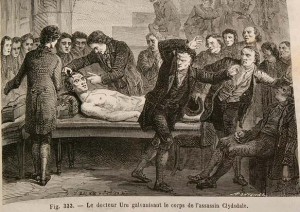
Longing for the days before all that ethical experimentation foolishness.
#7-The Amazing Frederico. This is sorta the reverse of #6. It’s a similar neural implant, but this records your dreams in digital format so you can watch/edit/save them. I figure it could spawn an entire alternative to Youtube as well as help people make sense out of those straggly fragments that bounce about right after they get up.
#8-Light ‘N Flat. This will be especially popular with Maine folks. Imagine a truck that has a row of adjustable intensity lasers as wide as one lane of traffic. They heat cracked and broken pavement until it’s malleable. Just behind the laser line is a water filled roller to pack and even the newly heated pavement. Since they could run these at night when there’s less traffic, long stretches of damaged road could be rehabbed quickly and at a substantial savings to cash strapped rural areas.

Some ideas are hotter than others
#9-The Michael Moorecrobe. There are experimental iterations of this already out there, but mine’s classier and safer as well as lucrative. It’s a genetically modified bacteria strain that LOVES toxic waste and hazardous/difficult to recycle trash. The nastier the substance, the happier these little critters are. Have spent fuel rods…Yum, they’ll eat ’em and poop something like platinum or palladium. Dioxin or DDT, “No Problemo, heap my plate!” they’ll exclaim. Best of all when they consume all the bad stuff in one spot, they go dormant until released at another hazardous area and they can switch dietary preferences on the fly. What’s not to like? A Toxic Politico strain is currently in rapid development.
#10-The Backatcha App. I suspect everyone will want one and Intel should develop it simply for the repeat order potential. Download this to your computer and every time you’re spammed, the program sends a response capable of cutting through all the forged headers. When it reaches the origination source, it fries the hard drive and motherboard. Spamming becomes very expensive.
I have more, but these are some of the more interesting ones. I’d love to hear about some of yours.





